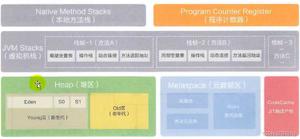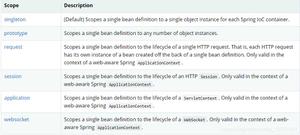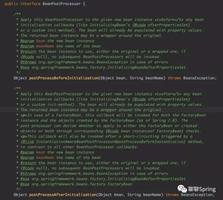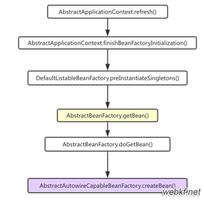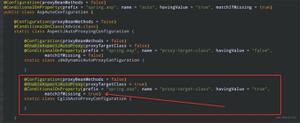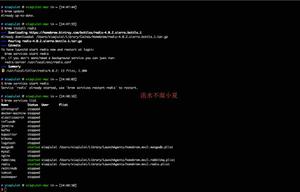Spring中bean的生命周期详解(面试说辞)
本文内容纲要:
- Spring中bean的生命周期" title="bean的生命周期">bean的生命周期(详解)- 四个主要阶段
- 常用的扩展点
- 影响多个bean的接口
- 只调用一次的接口
- 与aware有关的接口
- 两个生命周期接口
- 总结:
链接:https://blog.csdn.net/knknknkn8023/article/details/107130806/
Spring中bean的生命周期(详解)
1.四个主要阶段
2.常用的扩展点
3.影响多个bean的接口
4.只调用一次的接口
5.与aware有关的接口
6.两个生命周期接口
7.总结:
四个主要阶段
Spring bean的生命周期只有四个主要阶段,其他都是在这四个主要阶段前后的扩展点,这四个阶段是:
1.实例化 Instantiation
2.属性赋值 Populate
3.初始化 Initialization
4.销毁 Destruction
其中实例化和属性赋值分别对应构造方法和setter方法的注入,初始化和销毁是用户能自定义扩展的两个阶段。
可通过查源码的方式发现,他们都在doCreate()方法中,
// 忽略了无关代码protected Object doCreateBean(final String beanName, final RootBeanDefinition mbd, final @Nullable Object[] args)
throws BeanCreationException {
// Instantiate the bean.
BeanWrapper instanceWrapper = null;
if (instanceWrapper == null) {
// 实例化阶段!
instanceWrapper = createBeanInstance(beanName, mbd, args);
}
// Initialize the bean instance.
Object exposedObject = bean;
try {
// 属性赋值阶段!
populateBean(beanName, mbd, instanceWrapper);
// 初始化阶段!
exposedObject = initializeBean(beanName, exposedObject, mbd);
}
}
可以发现,分别调用三种方法:
1.createBeanInstance() -> 实例化
2.populateBean() -> 属性赋值
3.initializeBean() -> 初始化
而销毁阶段是在容器关闭时调用的,在ConfigurableApplicationContext类的close()中
常用的扩展点
影响多个bean的接口
两个最重要的接口:
InstantiationAwareBeanPostProcessor
BeanPostProcessor
实现这两个接口的bean,会自动切入到相应的生命周期中,其中InstantiationAwareBeanPostProcessor是作用于实例化阶段的前后,BeanPostProcessor是作用于初始化阶段的前后。
具体代码如图:
package cn.xmx.ioc.lifecycle;import org.springframework.beans.BeansException;
import org.springframework.beans.PropertyValues;
import org.springframework.beans.factory.config.InstantiationAwareBeanPostProcessorAdapter;
import java.beans.PropertyDescriptor;
public class MyInstantiationAwareBeanPostProcessorAdapter extends InstantiationAwareBeanPostProcessorAdapter {
@Override
public Object postProcessBeforeInstantiation(Class<?> beanClass, String beanName) throws BeansException {
if(beanName.equals("car")){
System.out.println(beanName+"在实例化之前");
}
return super.postProcessBeforeInstantiation(beanClass, beanName);
}
@Override
public boolean postProcessAfterInstantiation(Object bean, String beanName) throws BeansException {
if(beanName.equals("car")){
System.out.println(beanName+"在实例化之后");
}
return super.postProcessAfterInstantiation(bean, beanName);
}
}
package cn.xmx.ioc.lifecycle;
import java.lang.reflect.Proxy;
import org.springframework.beans.BeansException;
import org.springframework.beans.factory.config.BeanPostProcessor;
//后置处理器
public class NdBeanPostProcessor implements BeanPostProcessor {
public Object postProcessBeforeInitialization(Object bean, String beanName) throws BeansException {
System.out.println("NdBeanPostProcessor 在"+beanName+"对象初始化之【前】调用......");
if(beanName.equals("car")) {
return new CglibInterceptor().getIntance(bean.getClass());
}
return bean;
}
public Object postProcessAfterInitialization(Object bean, String beanName) throws BeansException {
System.out.println("NdBeanPostProcessor 在"+beanName+"对象初始化之【后】调用......");
return bean;
}
}
package cn.xmx.ioc.lifecycle;
import org.springframework.beans.factory.config.BeanPostProcessor;
import org.springframework.beans.factory.config.InstantiationAwareBeanPostProcessorAdapter;
import org.springframework.context.annotation.Bean;
import org.springframework.context.annotation.Configuration;
@Configuration
public class MainConfig {
@Bean(name="car",initMethod="init",destroyMethod="destroy")
public Car getCar() {
return new Car("大黄蜂");
}
@Bean
public BeanPostProcessor getBeanPostProcessor() {
return new NdBeanPostProcessor();
}
@Bean
public InstantiationAwareBeanPostProcessorAdapter getIns(){
return new MyInstantiationAwareBeanPostProcessorAdapter();
}
}
package cn.xmx.ioc.lifecycle;
import org.springframework.context.annotation.AnnotationConfigApplicationContext;
/*
四个主生命周期
(1)实例化之前干预 InstantiationAwareBeanPostProcessorAdapter.postProcessBeforeInstantiation()
1.实例化
(2)实例化之后干预 InstantiationAwareBeanPostProcessorAdapter.postProcessAfterInstantiation()
2.填充属性(给属性赋值)
(1)初始化之前干预 BeanPostProcessor.postProcessBeforeInitialization()
3.初始化化(比如准备资源文件)
3) 属性进行干预 ----修改属性或属性值
(2)初始化之后干预 BeanPostProcessor.postProcessAfterInitialization()
4.销毁(释放资源---对象从内存销毁)
N个接口
1、干预多次
1)BeanPostProcessor
2、干预一次
1)Aware
*/
public class TestLifeCycle {
public static void main(String[] args) {
AnnotationConfigApplicationContext context = new AnnotationConfigApplicationContext(MainConfig.class);
Car car = (Car) context.getBean("car");
System.out.println(car);//toString
System.out.println("beanname:"+car.getBeanName());
System.out.println("beanfactory:"+car.getBeanFactory());
System.out.println("applicationContext:"+car.getApplicationContext());
}
}
只调用一次的接口
与aware有关的接口
BeanNameAware
BeanFactoryAware
ApplicationContextAware
需要实体类实现这些接口,分别调用 Bean 的 setBeanName() 方法传入当前 Bean 的 id 值,调用 setBeanFactory() 方法传入当前工厂实例的引用,调用 setApplicationContext() 方法传入当前 ApplicationContext 实例的引用。
具体代码如下图所示:
package cn.xmx.ioc.lifecycle;import org.springframework.beans.BeansException;
import org.springframework.beans.factory.BeanFactory;
import org.springframework.beans.factory.BeanFactoryAware;
import org.springframework.beans.factory.BeanNameAware;
import org.springframework.context.ApplicationContext;
import org.springframework.context.ApplicationContextAware;
public class Car implements BeanNameAware, BeanFactoryAware, ApplicationContextAware {
private String name;
private String beanName;
private BeanFactory beanFactory;
private ApplicationContext applicationContext;
public void init() {
System.out.println("car 在初始化---加载资源");
}
public void destroy() {
System.out.println("car 在销毁---释放资源");
}
public Car() {
super();
}
public String getName() {
return name;
}
public void setName(String name) {
this.name = name;
}
public Car(String name) {
super();
this.name = name;
System.out.println("car实例化了");
}
public void setBeanFactory(BeanFactory beanFactory) throws BeansException {
System.out.println("beanFactory:"+beanFactory);
this.beanFactory = beanFactory;
}
public BeanFactory getBeanFactory(){
return this.beanFactory;
}
public void setBeanName(String s) {
System.out.println("beanName:"+s);
this.beanName = s ;
}
public String getBeanName() {
return this.beanName;
}
public ApplicationContext getApplicationContext() {
return this.applicationContext;
}
public void setApplicationContext(ApplicationContext applicationContext) throws BeansException {
System.out.println("applicationContext:"+applicationContext);
this.applicationContext = applicationContext;
}
}
两个生命周期接口
实例化和属性赋值都是Spring帮助我们做的,能够自己实现的有初始化和销毁两个生命周期阶段。
1.InitializingBean 对应生命周期的初始化阶段,在源码的invokeInitMethods(beanName, wrappedBean, mbd);方法中调用。
2.DisposableBean 类似于InitializingBean,对应生命周期的销毁阶段,以ConfigurableApplicationContext#close()方法作为入口,实现是通过循环取所有实现了DisposableBean接口的Bean然后调用其destroy()方法 。
总结:
Bean 生命周期的整个执行过程描述如下:
1.如果创建了一个类继承了InstantiationAwareBeanPostProcessorAdapter接口,并在配置文件中配置了该类的注入,即InstantiationAwareBeanPostProcessorAdapter和bean关联,则Spring将调用该接口的postProcessBeforeInstantiation()方法。
2.根据配置情况调用 Bean 构造方法或工厂方法实例化 Bean。
3.如果InstantiationAwareBeanPostProcessorAdapter和bean关联,则Spring将调用该接口的postProcessAfterInstantiation()方法。
4.利用依赖注入完成 Bean 中所有属性值的配置注入。
5.如果 Bean 实现了 BeanNameAware 接口,则 Spring 调用 Bean 的 setBeanName() 方法传入当前 Bean 的 id 值。
6.如果 Bean 实现了 BeanFactoryAware 接口,则 Spring 调用 setBeanFactory() 方法传入当前工厂实例的引用。
7.如果 Bean 实现了 ApplicationContextAware 接口,则 Spring 调用 setApplicationContext() 方法传入当前 ApplicationContext 实例的引用。
8.如果 BeanPostProcessor 和 Bean 关联,则 Spring 将调用该接口的预初始化方法 postProcessBeforeInitialzation() 对 Bean 进行加工操作,此处非常重要,Spring 的 AOP 就是利用它实现的。
9.如果 Bean 实现了 InitializingBean 接口,则 Spring 将调用 afterPropertiesSet() 方法。
10.如果在配置文件中通过 init-method 属性指定了初始化方法,则调用该初始化方法。
11.如果 BeanPostProcessor 和 Bean 关联,则 Spring 将调用该接口的初始化方法 postProcessAfterInitialization()。
注意:以上工作完后才能以后就可以应用这个bean了,那这个bean是一个singleton的,所以一般这种情况下我们调用同一个id的bean会是在内容地址相同的实例,当然在spring配置文件中也可以配置非Singleton。
12.如果 Bean 实现了 DisposableBean 接口,则 Spring 会调用 destory() 方法将 Spring 中的 Bean 销毁;如果在配置文件中通过 destory-method 属性指定了 Bean 的销毁方法,则 Spring 将调用该方法对 Bean 进行销毁。
本文内容总结:Spring中bean的生命周期(详解),四个主要阶段,常用的扩展点,影响多个bean的接口,只调用一次的接口,与aware有关的接口,两个生命周期接口,总结:,
原文链接:https://www.cnblogs.com/xushuanglong/p/14632982.html
以上是 Spring中bean的生命周期详解(面试说辞) 的全部内容, 来源链接: utcz.com/z/362444.html

